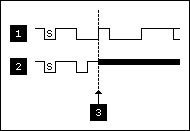CAN Identifiers and Message Priority
When a CAN device transmits data onto the network, an identifier that is unique throughout the network precedes the data. The identifier defines not only the content of the data, but also the priority.
When a device transmits a message onto the CAN network, all other devices on the network receive that message. Each receiving device performs an acceptance test on the identifier to determine if the message is relevant to it. If the received identifier is not relevant to the device (such as RPM received by an air conditioning controller), the device ignores the message.
When more than one CAN device transmits a message simultaneously, the identifier is used as a priority to determine which device gains access to the network. The lower the numerical value of the identifier, the higher its priority.
The following figure shows two CAN devices attempting to transmit messages, one using identifier 647 hex, and the other using identifier 6FF hex. As each device transmits the 11 bits of its identifier, it examines the network to determine if a higher-priority identifier is being transmitted simultaneously. If an identifier collision is detected, the losing device(s) immediately stop transmission, and wait for the higher-priority message to complete before automatically retrying. Because the highest priority identifier continues its transmission without interruption, this scheme is referred to as nondestructive bitwise arbitration, and CAN's identifier is often referred to as an arbitration ID. This ability to resolve collisions and continue with high-priority transmissions is one feature that makes CAN ideal for real-time applications.

| 1 Device A: ID = 11001000111 (647 hex) |
| 2 Device B: ID = 11011111111 (6FF hex) |
| 3 Device B Loses Arbitration; Device A Wins Arbitration and Proceeds |
| S = Start Frame Bit |